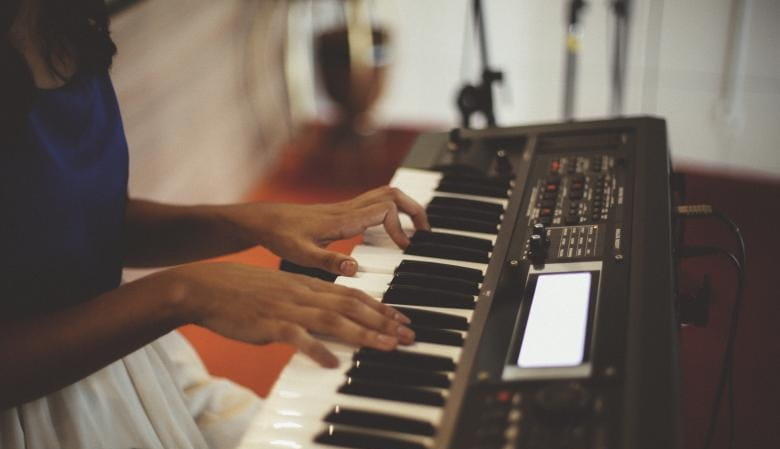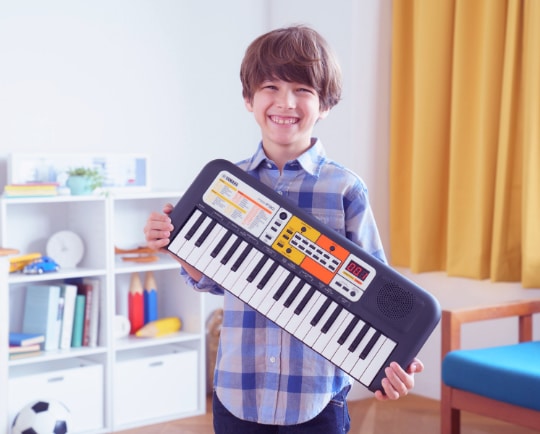Learning to play the electronic keyboard is still a popular part of any music lesson in the classroom.
Due to this popularity however, there are endless electronic keyboards available for use in the classroom.
But which electronic keyboards are the best for the classroom?
Read on for our recommendations.

“Hi I’m Jessica from Aeon Reviews, here we will look at the best electronic keyboards for the classroom.”
What To Look For In Classroom Electronic Keyboards (Buyers Guide)
There are some areas to consider when considering the spec of your classroom keyboard.
Number of Keys
Keyboards are available with a different number of keys.
You will find the most popular electronic keyboards and digital pianos come with 49, 61, 73 or the full 88 keys.
Beginners typically learn the basics with fewer keys, however it is beneficial to start with a keyboard which has more keys, so the instrument can grow with the student as they progress with their playing.
This way, you can play everything, regardless of which octave it is in.
Keep in mind that the more keys the keyboard has, the wider it will physically be.
Music Holder/Rest
Beginners to the piano or keyboard will want to make sure that they can easily read sheet music or lesson books.
The easiest way to do this is by using a music stand.
Many digital pianos feature a built-in stand, which can be useful, however you may decide this is not essential.
Keyboard Stand
Decide where you will be playing the keyboard, and this will dictate whether a stand is needed.
For some classes, placing the keyboard on a desk or table will suffice. However some situations may necessitate a stand.
Some electronic keyboards come with a stand included, and some don’t. However it is easy to pick up a stand at a later date if needed. These stands typically fold away also for easy storage.
Weighted/Unweighted Keys
If you wish to feel like you are playing an actual piano, weighted keys are a good choice.
Keep in mind this will increase the overall weight of the keyboard. This may be a consideration if you intend to regularly transport the keyboard, or if you intend to store them away at the end of a lesson.
Unweighted keys are easier to push down, making for a more beginner friendly experience for younger players.

Velocity Sensitive Keys
This is a feature on some keyboards. Keys respond differently depending on how much force they are hit with.
Playing a keyboard gently will result in softer sounds, while playing harder produces more volume.
Computer Connectivity
Many keyboard brands offer computer connectivity. This isn’t an essential feature, but it may be beneficial for any students planning to create their own music with using computer based software.
Buying a keyboard with computer connectivity now may help avoid the need to upgrade the keyboard in the future.
Check what is mentioned under connectivity on the keyboard’s description.
Onboard Storage
Although not an essential feature, some keyboards offer the option of inbuilt storage.
These keyboards typically allow you to download more sounds and presets than are included out of the box.
Size/Dimensions
If you are storing these keyboards in a classroom then the size might be a consideration for you.
A large number of keyboards may take up valuable space in a classroom, store room, or cupboard.
Best Electronic Keyboard For The Classroom
1/ Casio CT-S300 (Best All-Rounder)
2/ Yamaha Mini-key Portable Keyboard PSS-F30 (Best Budget Keyboard For Kids)
3/ Casio SA76 (Best Value Overall)
4/ JoyMusic JK-61 (Best All-In-One Package)
5/ Roland FP-30X (Best 88 Key Classroom Digital Piano)
Affiliate Disclaimer – aeonreviews.com is a participant in the Amazon Services LLC Associates Program, an affiliate advertising program designed to provide a means for sites to earn advertising fees by advertising and linking to Amazon.com. We earn commissions for purchases made through links in this post.
1/ Casio CT-S300 (Best All-Rounder)

Pros
Trusted Brand
Wide Range of Sounds Cons
Sound Is Fair
Trusted Brand
Wide Range of Sounds
Sound Is Fair
Accessories – Keyboard Stand, Headphones, Lesson Software, AC Adapter
Connectivity – MIDI USB, 1 x 1/8″/3.5 mm TRS Aux Input, 1 x 1/8″/3.5 mm TRS Headphone Output
Pedal Support – 1 x 1/4″ Damper/Sustain
Power Supply – Battery or AC Adapter
Dimensions (LxWxH) – 10.08 x 36.61 x 2.83 inches
Casio has long been one of the most trusted brands in the portable keyboard world.
And their entry level keyboards always offer great bang for your buck!
The CT-S300 offers a great range of features for the price.
This is a full-size, velocity-sensitive 61-note keyboard. Includes a convenient built-in carrying handle, and comes in three colour options (black, white or red).
This is a particularly user friendly model, as the ‘My Setup’ button easily recalls your favourite sounds and settings.

A library of over 400 tones is included, 77 rhythms, 60 songs, built-in reverb, and a dance music mode (for easily remixing dance music tracks).
Includes aux input, USB connectivity, and is compatible with Casio’s Chordana teaching app. You even get a 60-song songbook thrown in!
This is a velocity-sensitive keyboard, so users will have fun experimenting with the different sound this produces depending on how it is played.
Also includes a power supply and music rest.
Overall, a really great quality keyboard, which is difficult to beat at this price. Advanced users may feel they want a richer sound, but the CT-S300 delivers a sound which is a cut above many in it’s class.
2/ Yamaha Mini-key Portable Keyboard PSS-F30 (Best Budget Keyboard For Kids)

Pros
Price
Great For Younger Kids Cons
Basic Sound
Price
Great For Younger Kids
Basic Sound
Accessories – USB Cable, Song Book (download)
Connectivity – Headphone Output, USB Micro B
Pedal Support – No
Power Supply – Battery or USB Charger
Dimensions (LxWxH) – 9.1 x 21.5 x 3.8 inches
If you are looking for a great value entry level keyboard for younger students, then look no further than the Yamaha PSS-F30.
The 37 mini keys on this keyboard are designed to be easy to play.
The PSS-F30 comes with 120 voices (instruments) and 114 styles. And with the new smart chord function, you can enjoy playing styles with just one finger!
I love the basic, clean interface, and students will know exactly how to control the different features with ease.

Comes with a Mico USB cable, but power adapter is not included.
Play along to the 30 onboard songs, or access the free digital songbook.
Listen via the inbuilt speaker, or plug in headphones.
The PSS-F30 also weighs only 1.2kg, making it really portable. And if you wish to play on the go, simply insert four AA batteries, or plug in a USB mobile battery.
Feature rich, compact, and great value. Although the sound quality is somewhat basic, this keyboard is great for getting kids involved in playing music for the first time.
3/ Casio SA76 (Best Value Overall)

Pros
Best Value
Fresh Design & Interface Cons
Light Keys
Best Value
Fresh Design & Interface
Light Keys
Accessories – Power Supply, Removable Stickers, Instructional Book & DVD, and Polishing Cloth
Connectivity – Headphone Output
Pedal Support – No
Power Supply – Battery or Power Adapter
Dimensions (LxWxH) – 10 x 26 x 5 inches
If you are really on a budget, but don’t want to compromise in terms of features, then definitely check out the Casio SA76.
This keyboard features 44 mini-sized keys and 5 percussion drum pads.
In terms of built in sounds, you can access 100 sounds (such as pianos, guitars, saxophones and more), 50 rhythm patterns, and also easily choose from a piano or organ tone from one big orange button.
A great keyboard for any beginner wishing to learn octaves or chords due to it’s smaller size.
Beginners may also value the small LCD screen which displays the notes you play, serving as a great introduction to music notation.

Students can also take their first steps in playing music by playing along with the 10 built in songs.
You can also mute the melody to these tracks, leaving the backing track for you to play along to.
Power the SA76 using the FREE power adapter, or by battery (6 x AA).
The SA76 is also fully portable and has a headphone port.
Pretty much unbeatable on price, and even includes a power supply (something that is extra with many brands). The keys do feel somewhat light, and really quite different to a normal piano. However this is still a really beginner friendly electronic keyboard, with a sound that is surprisingly great for the price.
4/ JoyMusic JK-61 (Best All-In-One Package)

Pros
Includes Everything You Need
Unbeatable Value Cons
Accessories Feel Basic
Includes Everything You Need
Unbeatable Value
Accessories Feel Basic
Accessories – Keyboard Stand, Stool, Headphones, Microphone, Music Holder, Power Supply
Connectivity – MIC, Audio Input, Phone Output x 2
Pedal Support – No
Power Supply – Battery or Power Adapter
Dimensions (LxWxH) – 12.7 x 33.8 x 4.1 inches
If you want a great keyboard for the classroom, that comes with all the accessories that you might need to get started, then check out the JK-61 from JoyMusic.
This 61 key keyboard itself is packed with features, but also includes a keyboard stand, headphones, seat, music stand, and microphone, all in one package!
What amazed me the most was that this package is available for less than many manufactures charge for a keyboard alone!
Perfect for beginners, the JK-61 includes 255 Rhythms, 8 Percussions And 24 Demo Songs.
The LCD screen displays selected modes and other information, but can also be used to display markers to guide learning.

For example the JK-61 shows the correct chords and keys to play along to when playing demo songs.
The JK-61 includes many functions to customize the players sound. This includes adjustable volume and tempo, recording playback, vibrato and much more.
Features connection ports for a MIC, headphones, audio input/output jack, and a power supply (included).
The only real complaint here is that the accessories feel very basic and there may be question marks around the longevity of the headphones, mic, etc.
Overall though, a great all-in-one electronic keyboard package for the classroom.
5/ Roland FP-30X (Best 88 Key Classroom Digital Piano)

Pros
Real Piano Sound
Weighted Keys Cons
Included Pedal Is Small
Real Piano Sound
Weighted Keys
Included Pedal Is Small
Accessories – Free Online Piano Lessons
Connectivity – USB Port: USB Type B, Update port A, Phones Jack (useable as output jack), Stereo Miniature Output, Bluetooth Midi
Pedal Support – Yes
Power Supply – Power Adapter
Dimensions (LxWxH) – 11.2 x 51.2 x 11.2 x 6 inches
If your priority is emulating the sound of a traditional piano then a digital piano is a must.
This type of piano is ideal for those who want to learn piano, but without the incredibly high price tag.
There are many available on the market today, however the Roland FP-30X is my pick due to how well it balances affordability with incredible performance.
The SuperNATURAL Piano sound technology samples real piano sounds to emulate the sound and decay of actual piano notes.
And the action of the weighted keys are very close to that of a real piano.
The included foot switch does a pretty good job as a sustain pedal.

Select from a range of onboard sounds, including electric pianos, organs, strings, and synthesizers.
Includes a built in 22-watt stereo speaker system so you can fill the room with sound.
The quiet keyboard action means you can plug in a pair of headphones and not disturb anyone.
The FP-20X also includes Bluetooth connectivity to allow you to stream music to the keyboard and play along.
You also get three months of piano lessons delivered by Pianote, which includes lives lessons and support from real piano teachers.
The only real criticism here is that the included sustain pedal is somewhat small, and can move about a lot. However this could be replaced with a more robust one if needed.
Overall, the Roland FP-30X is an excellent digital piano, and worth the extra cost if you stretch to it.
Conclusion
Hopefully this article helped you find the best electronic keyboard for music lessons in the classroom.
Check out similar articles like this right here at aeonreviews.com, such as our article on durable classroom headphones.

